Thinking back to my childhood, my grandmother’s beef stew is a standout. It warmed our home during the cold winter months. The smell of slow-cooked meat and veggies is unforgettable.
A homemade beef stew recipe is special because it’s shared through generations. It’s not just food; it’s a way to connect with our past and share love. Here, I’ll share my version of this classic dish and how to make it your own.
Key Takeaways
- A simple and comforting homemade beef stew recipe
- Tips for customizing the dish to your taste
- The significance of this classic recipe in different cultures
- Variations to suit different dietary preferences
- Step-by-step guide to preparing a delicious homemade beef stew
The Comfort of a Classic Beef Stew
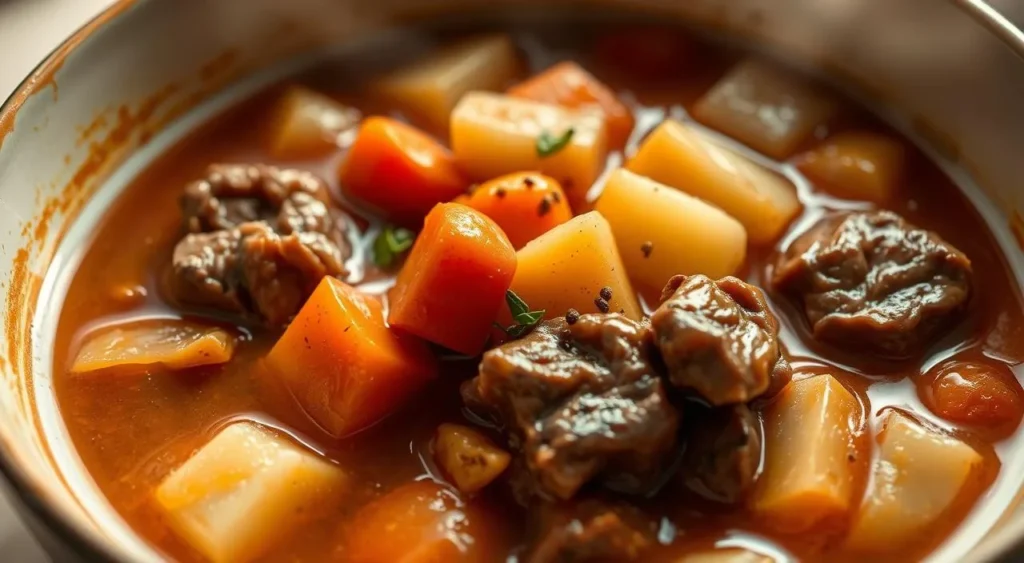
Classic beef stew is more than a meal; it’s a heartwarming experience. It brings people together with its comforting taste.
Why Beef Stew Remains a Beloved Dish
Beef stew is loved for its warmth and simple ingredients. It’s a dish that:
- Evokes feelings of warmth and comfort
- Is easy to prepare, yet rich in flavor
- Can be adapted to various tastes and dietary needs
My Personal Connection to This Recipe
For me, classic beef stew is a family tradition. My grandmother made it for us on cold winter nights. It was always a highlight of my week.
The smell of slow-cooked beef and vegetables reminds me of those cozy evenings. I’ve kept this tradition alive, making it part of my family’s culinary heritage.
The beauty of a hearty beef stew is its versatility and the love it shares. Whether for a crowd or a quiet night, it’s sure to become a favorite.
Understanding the Perfect Beef Stew
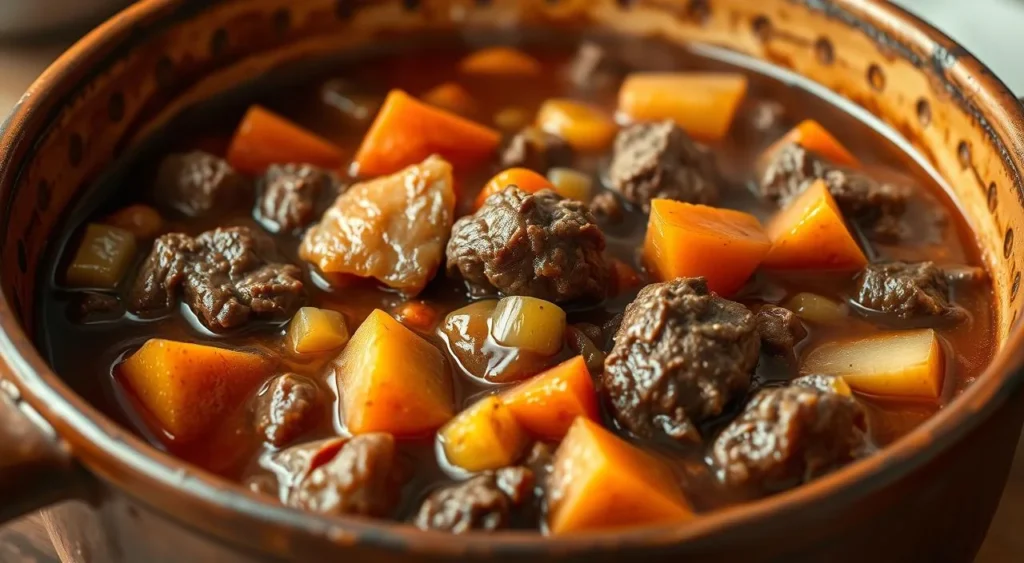
>Learn more about how browning beef enhances flavor from this detailed guide by Serious Eats.
A great beef stew is more than just a mix of ingredients. It’s a perfect blend of flavors and textures. To get this right, you need to know the key parts of a traditional beef stew.
Key Components of a Great Beef Stew
The heart of a great beef stew is its main parts. These parts work together to make a dish that’s both rich and satisfying.
The Balance of Flavors
A top-notch beef stew has a mix of savory, sweet, and umami flavors. This mix comes from beef, veggies, and broth. It’s also enhanced with herbs and spices.
- Savory flavors come from the beef and broth.
- Sweetness is added by veggies like carrots and onions.
- Umami depth is from tomato paste or mushrooms.
Texture Considerations
The texture of a beef stew is as important as its taste. A good stew has tender beef and veggies cooked just right.
- Browning the beef gives it a rich, caramelized crust.
- Slow cooking makes the meat tender and easy to shred.
- Vegetables should be tender but not too soft.
Regional Variations Across America
Beef stew varies a lot across America. This shows how different tastes and ingredients are used in different places.
In the South, beef stew might have okra or Cajun and Creole spices. In the Northeast, it might include maple syrup or cranberries.
Essential Ingredients for Homemade Beef Stew
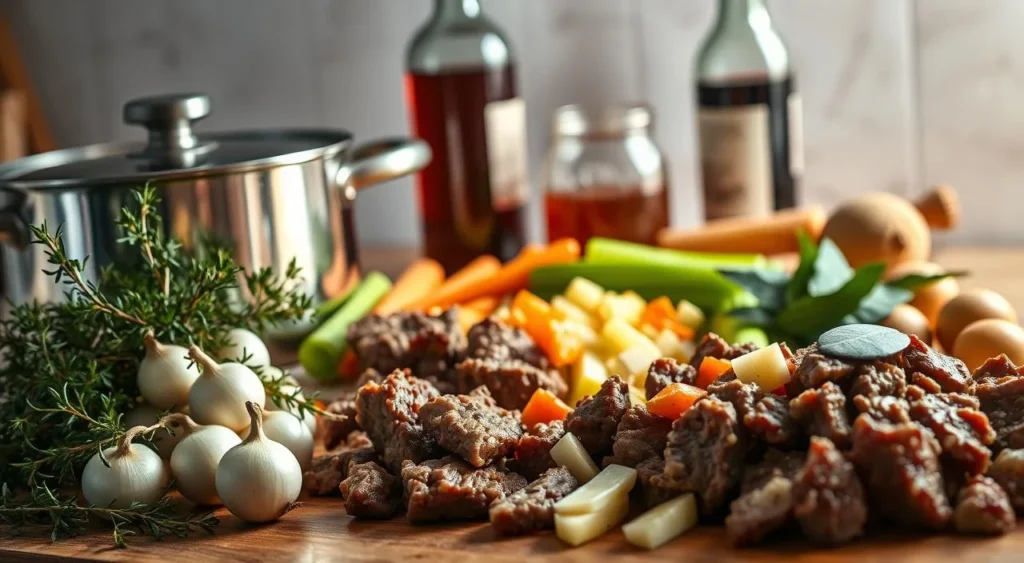
To make a comforting homemade beef stew, picking the right ingredients is key. The quality and mix of these ingredients affect the flavor and enjoyment of the dish.
Selecting the Best Cuts of Beef
The type of beef is vital for a great easy beef stew recipe. Different cuts offer different tenderness and flavors.
Not sure if your meat is cooked through? Refer to the USDA’s safe temperature chart.
Chuck Roast vs. Stew Meat
Chuck roast and stew meat are top picks. Chuck roast is loved for its rich taste and tender texture when slow-cooked. Stew meat, a mix of cuts, is easier to find.
Marbling and Why It Matters
Marbling, or the fat inside the meat, is key for tenderness and flavor. Cuts with good marbling make the beef stew more tender and tasty.
Vegetables That Create the Foundation
Vegetables are the heart of a hearty beef stew. Onions, carrots, and potatoes are staples, adding flavor and texture. Celery and parsnips bring more depth and complexity.
Herbs and Seasonings for Depth of Flavor
Herbs and seasonings are essential for a flavorful best beef stew recipe. Thyme, rosemary, and bay leaves are classic. Salt, pepper, and garlic are must-haves for seasoning.
>Explore the health benefits of herbs like thyme and rosemary in this Healthline article.
Liquid Components: Broth, Wine, and Alternatives
The liquid is key for tenderizing the beef and blending flavors. Beef broth is common, but red wine or broth and wine mix can add richness. Mushroom or vegetable broth can offer unique twists.
Choosing each ingredient with care makes a satisfying and delicious homemade beef stew. It captures the essence of a best beef stew recipe.
Equipment Needed for Your Beef Stew
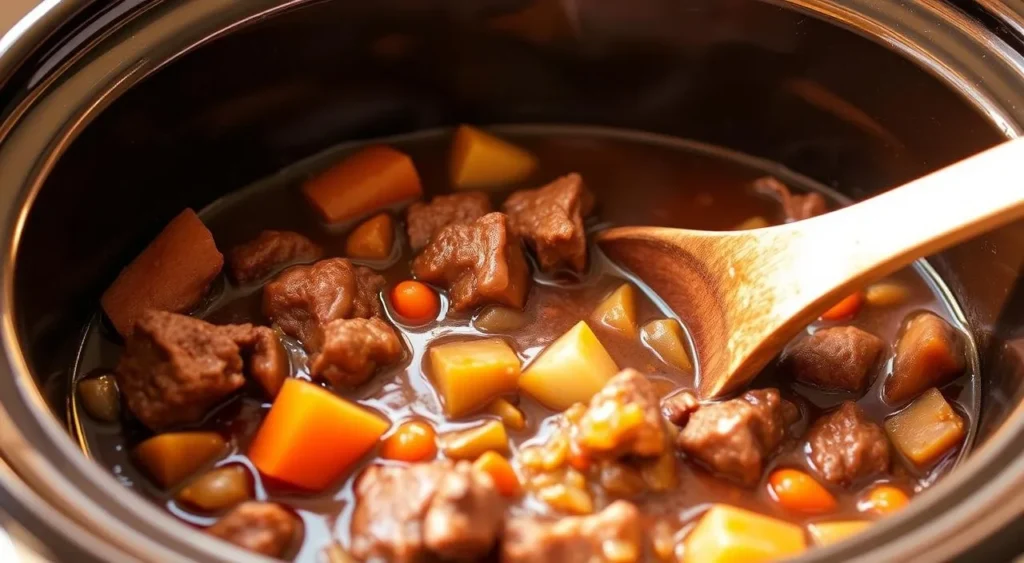
Cooking a tasty beef stew needs the right tools. The right equipment makes cooking easier and more fun.
Dutch Oven vs. Slow Cooker Options
Choosing between a Dutch oven and a slow cooker depends on your cooking style. A Dutch oven is great for browning meat and cooking veggies before slow-cooking. A slow cooker, on the other hand, lets you cook your slow cooker beef stew without much effort.
Additional Kitchen Tools for Preparation
There are other tools you’ll need to prepare a fantastic beef stew.
Knives and Cutting Boards
A sharp knife and a solid cutting board are key. They help you chop veggies and trim meat.
Measuring Tools and Timers
Measuring cups and spoons help you get the right amounts of each ingredient. A timer keeps you on track with cooking times.
With the right tools, you’re ready to make a delicious homemade beef stew.
My Classic Beef Stew Recipe

After years of perfecting my technique, I’m ready to share my go-to beef stew recipe. This comforting dish is a staple in my kitchen. I’m excited to walk you through the steps to create it.
Preparing Your Ingredients
The key to a great beef stew recipe starts with preparing your ingredients. This includes chopping vegetables, measuring out spices, and having your beef ready to go.
- Chop 2 medium onions
- Mince 3 cloves of garlic
- Cut 2 pounds of beef into 1 1/2-inch pieces
Browning the Meat Properly
Browning the meat is a key step in developing the flavor of your homemade beef stew. It’s essential to get a good sear on the beef.
Temperature and Timing Tips
Heat a Dutch oven over medium-high heat, add a tablespoon of oil, and sear the beef in batches until browned on all sides. This should take about 5 minutes per batch.
Building Flavor with Aromatics
After browning the meat, it’s time to build the flavor with aromatics. This involves sautéing the chopped onions and minced garlic until they’re softened and fragrant.
Simmering to Perfection
Simmering is where the magic happens in a beef stew recipe. It’s essential to let it cook slowly. This allows the flavors to meld together and the beef to become tender.
Adjusting Consistency and Seasoning
Lastly, adjust the consistency and seasoning of your stew. If it’s too thick, add a bit more broth. If it’s too thin, simmer it for a bit longer. Taste and adjust the seasoning as needed.
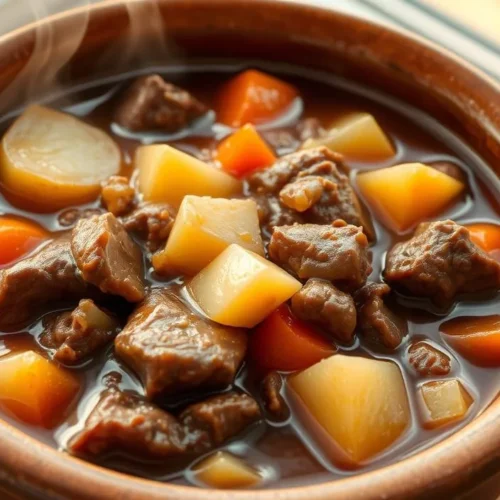
Classic Homemade Beef Stew Recipe
Ingredients
- 2 lbs beef chuck cut into 1.5-inch cubes
- 3 tablespoons all-purpose flour
- 2 tablespoons olive oil
- 1 large onion chopped
- 3 cloves garlic minced
- 3 tablespoons tomato paste
- 4 cups beef broth
- 1 cup red wine optional, can substitute with more broth
- 4 carrots sliced into chunks
- 3 potatoes peeled and diced
- 2 celery stalks chopped
- 1 teaspoon dried thyme
- 1 teaspoon dried rosemary
- 2 bay leaves
- Salt and pepper to taste
- Fresh parsley chopped (for garnish)
Instructions
- Step 1/ Prep the Beef: Toss beef chunks in flour with a pinch of salt and pepper. Shake off excess flour.
- Step 2/ Brown the Beef: In a large Dutch oven, heat olive oil over medium-high heat. Brown the beef in batches, ensuring all sides are seared. Remove and set aside.
- Step 3/ Sauté Aromatics: In the same pot, add chopped onions and garlic. Sauté for 3–4 minutes until softened. Stir in tomato paste and cook for 1 minute.
- Step 4/ Deglaze: Pour in red wine (or extra broth), scraping the bottom to release browned bits. Let it simmer for 2 minutes.
- Step 5/ Build the Stew: Return the beef to the pot. Add beef broth, carrots, potatoes, celery, thyme, rosemary, and bay leaves. Stir well.
- Step 6/ Simmer: Bring to a boil, then reduce heat to low. Cover and simmer for 2 hours, stirring occasionally, until beef is fork-tender and vegetables are cooked through.
- Step 7/ Finish & Serve: Discard bay leaves. Taste and adjust seasoning. Garnish with chopped parsley. Serve hot with crusty bread or over mashed potatoes.
Slow Cooker Beef Stew Variation
Turning my classic beef stew into a slow cooker version is a big win for busy days. It lets you come home to a meal that’s already ready. This slow cooker beef stew is a great example of an easy beef stew that’s full of flavor.
Adapting the Recipe for a Slow Cooker
To make my beef stew for the slow cooker, start by browning the meat and sautéing the aromatics. Then, put everything in the slow cooker. This step is key for a rich flavor that makes a great stew.
Timing and Temperature Guidelines
Cooking time and temperature are important for a good slow cooker beef stew. Cook on low for 8-10 hours or high for 4-6 hours. Here’s a simple guide:
| Cooking Mode | Temperature | Cooking Time |
|---|---|---|
| Low | 275°F (135°C) | 8-10 hours |
| High | 300°F (150°C) | 4-6 hours |
Slow Cooker Tips for Maximum Flavor
To get the most flavor, don’t fill the slow cooker too much. Leave about 1/4 of the space empty for even cooking. Also, try not to open the lid too often, as it can make cooking take longer. For even more flavor, add a splash of red wine or a tablespoon of tomato paste.
By following these tips, you’ll have a delicious, comforting slow cooker beef stew that your family will love.
>Read this slow cooker guide for more helpful tips.
Creative Variations on Traditional Beef Stew
The classic beef stew is perfect for making over. You can change it in many ways, making it great for any meal.
Craving a French twist? Check out BBC Good Food’s authentic Beef Bourguignon recipe.
International Flavor Inspirations
Try adding flavors from around the world to your beef stew. For example, the French version, Beef Bourguignon, uses red wine and mushrooms for extra taste.
French Beef Bourguignon Style
The French dish, Beef Bourguignon, makes the stew tender and flavorful. It’s all about slow simmering to blend the flavors well.
Irish Guinness Beef Stew
The Irish Guinness Beef Stew uses Guinness stout for a deeper flavor. It’s great for those who want a more complex stew.
Dietary Adaptations
It’s easy to make beef stew fit different diets. You can choose gluten-free or lower-carb options with a few tweaks.
Gluten-Free Options
For a gluten-free stew, use gluten-free flour instead of regular flour. This change helps those with gluten issues enjoy the dish.
Lower-Carb Modifications
To make it lower-carb, use fewer potatoes and add more veggies like greens or broccoli. This cuts down carbs and boosts nutrients.
| Variation | Key Ingredients | Benefits |
|---|---|---|
| French Beef Bourguignon | Red wine, mushrooms | Rich flavor, tender meat |
| Irish Guinness Beef Stew | Guinness stout | Deep, robust flavor |
| Gluten-Free | Gluten-free flour | Accessible to those with gluten intolerance |
| Lower-Carb | More vegetables, fewer potatoes | Lower carb content, more nutrients |
Exploring these variations lets you enjoy beef stew in new, exciting ways. You can customize it to fit your taste and dietary needs.
Storing, Freezing, and Reheating Your Beef Stew Recipe
Storing, freezing, and reheating your beef stew right can make a big difference. It lets you enjoy it for days. The secret is to keep its flavor and texture just right.
Proper Storage Methods
For a fresh beef stew, use airtight containers. Glass containers with tight lids are best. They keep out moisture and other tastes.
Freezing Guidelines for Future Meals
Freezing is great for keeping your beef stew with vegetables fresh longer. Cool the stew down first. Then put it in freezer-safe containers or bags.
| Storage Method | Duration | Notes |
|---|---|---|
| Refrigeration | 3-4 days | Store in airtight containers |
| Freezing | 3-4 months | Cool completely before freezing |
Best Practices for Reheating Without Losing Quality
Reheating your beef stew right is key. Gently heat it on the stovetop or in the microwave. Stir often to keep it good.
FAQ
What is the best cut of beef for a beef stew recipe?
Chuck roast and stew meat are top picks for beef stew. Chuck roast is favored for its rich taste and tender texture when cooked slowly.
Can I make a classic beef stew in a slow cooker?
Yes, you can make a traditional beef stew in a slow cooker. It’s great for cooking without much effort, all day long.
What are some common vegetables used in homemade beef stew?
Carrots, potatoes, onions, and sometimes celery are common in beef stew. They add a hearty and flavorful base.
How can I achieve a rich flavor in my beef stew?
For a rich flavor, brown the meat well. Use onions and garlic for aromatics. Adding red wine or beef broth can also enhance the taste.
Can I freeze leftover beef stew, and if so, how?
Yes, you can freeze beef stew. Cool it down first. Then, put it in airtight containers or freezer bags. Store it in the freezer for up to 3 months.
What are some variations of traditional beef stew I can try?
Try international twists like French Beef Bourguignon or Irish Guinness Beef Stew. You can also make it gluten-free or lower-carb.
How do I reheat beef stew without losing its quality?
Reheat beef stew gently. Use low heat on the stovetop or in the microwave. Stir often to keep the meat tender and vegetables firm.
What is the ideal cooking time for a hearty beef stew?
Cooking time varies. Dutch oven cooking takes 2-3 hours. A slow cooker needs 8-10 hours on low.
Can I make a beef stew with other types of meat?
Yes, you can use other meats like lamb or venison. Just adjust cooking times and seasonings to suit.
Conclusion
Homemade beef stew is more than a meal; it’s a cozy experience. Knowing the key parts, picking the right ingredients, and using the right tools helps you make the best stew.
Whether you cook it in a Dutch oven or a slow cooker, the joy of making and sharing it is unmatched. I’ve shared my classic recipe and some creative twists to inspire you.
Now, it’s your turn to cook! Try the best beef stew recipe, play with different ingredients, and enjoy the warmth it brings home. With each bite, you’ll enjoy a truly satisfying meal.
More Recipe Ideas You’ll Love:
- How to Make Homemade Cereal Bars at Home in 5 Easy Steps
- Irresistible Roast Beef Tenderloin for Any Occasion
- How To Make The Perfect Strawberry Glaze In 10 Minutes
💬 Share Your Thoughts & Rate This Recipe!
Tried this Homemade Beef Stew Recipe?
👇 We’d love to hear how it turned out!
⭐ Leave a star rating below to help others find this recipe.
📝 Drop a comment to share your tips, substitutions, or favorite sides!
Your feedback helps us improve and brings the @Recipizy community together. Let’s cook, share, and grow—one delicious dish at a time.






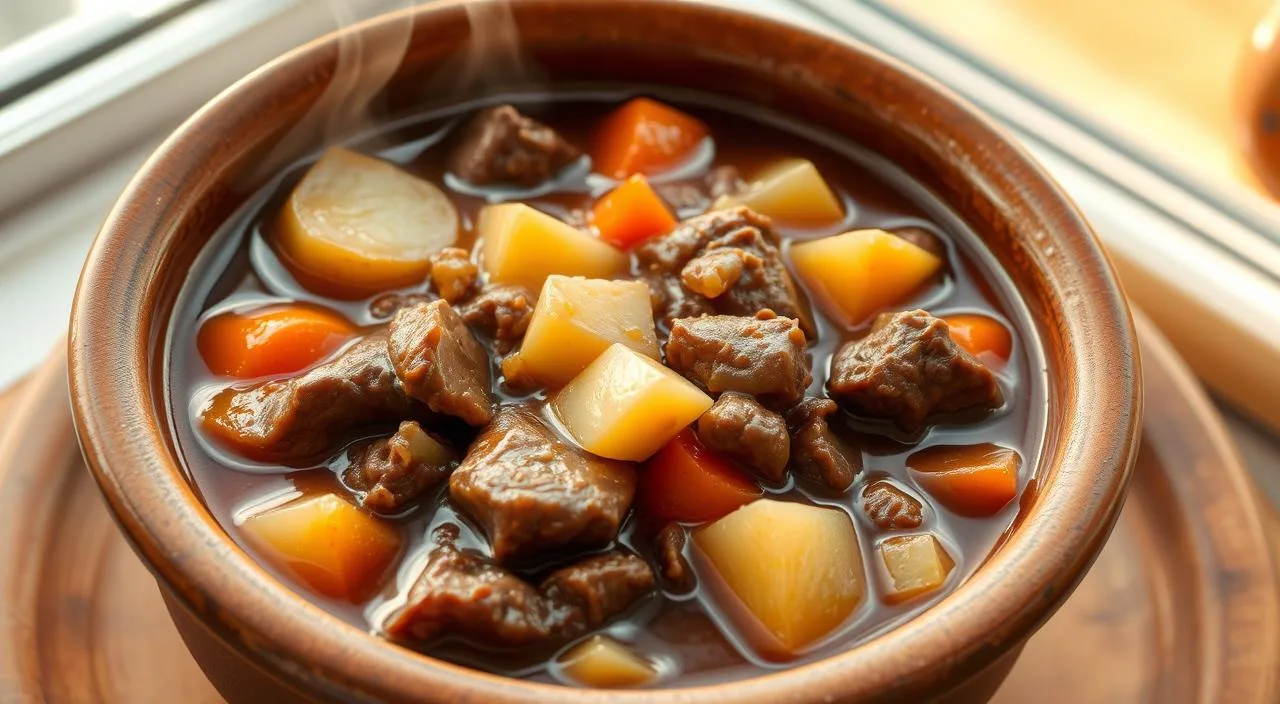
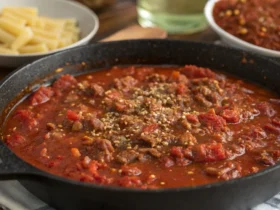
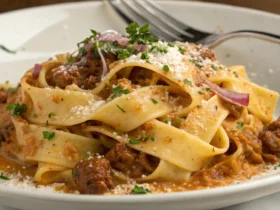

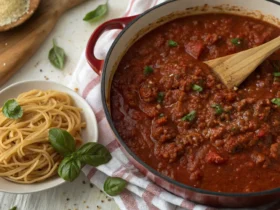

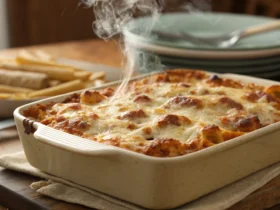
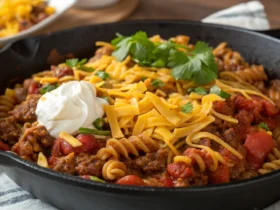

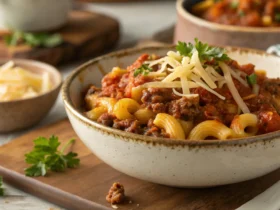
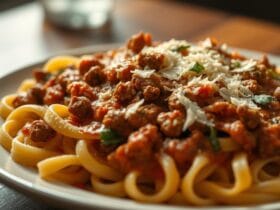
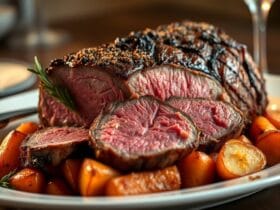
Super quick and tasty! I’ll be making this again for sure.